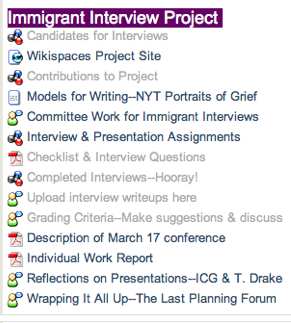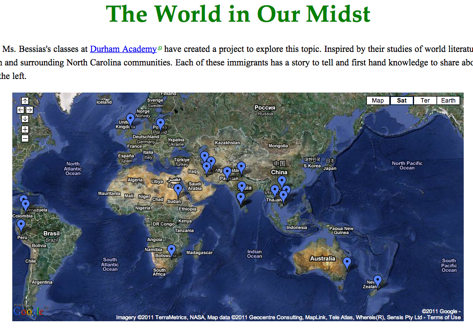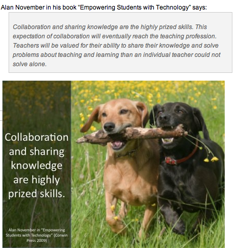
‘Dandelion in the wind’
http://www.flickr.com/photos/91273409@N00/140131319
Having gardened for many years, I know how tough it can be to contain all of the plants inside of my garden area. Learning and teaching inside of a walled garden like our Moodle has some of the same limitations. Sometimes, the learning needs to escape into the world’s garden. I have worked with Tina Bessias on many wonderful projects and for many years we conducted workshops together for teachers at our school. She has always been a teacher who looked to challenge both herself and her students with work that could have meaning after the class was over. I was excited to hear that she was also a NCAIS Master Teacher. She clearly is one and I think we will both benefit from the challenges we face with becoming one of the first group of Master Teachers. Her Master Teacher project was about Immigrants and Interviews. A neat idea and one that I thought her students would both enjoy while also being challenged.
I received a very nice message, (which prompte this post) from Tina. She granted me permission to post it here as I liked how she included the earlier work her students had done with me as a reason for some of the success of the project.
I took six 9th graders to the ICG Conference at Carolina Friends School on Thursday. Together, we presented our project to a small but engaged audience. Mostly, I let the students do it, and I wish you could have seen them. Nobody in the audience had used Moodle or created wikis before, and it was amazing to see the students’ work through their eyes. They made seamless transitions among discussion forums, Garage Band, photo editors, wiki templates, and the concepts of the project–the variety of experiences they heard about from immigrants, the enthusiasm with which they referenced “my immigrant”… It was a beautiful thing. And throughout the project, they have mentioned and built on what they learned in Middle School.
I responded thusly,
WOW! What a Wonderful World View Student Centered project! I have been poking around in your course and Wiki and am awed by what you were able to harness and produce. I am also proud of what those students were able to create and do and am glad that my teaching laid a foundation. Too often, I wonder if what I do continues to be nurtured. Clearly, this project represents a prime example of the roles of a 21st Century teacher and learner.
Tina is a heavy Moodle user at the Upper School as her courses contain most of the modules that are available for use in classes. She has used the wiki in Moodle for many years even though most Moodle users agree, it is not very good. Moodle 2.0 has a much better, built from the ground up wiki which we will hopefully be able to use next school year. What Tina has accomplish with her project is to do the MESSY teaching and learning aspects of her project inside the walled garden of our Moodle. Only students and teachers can access it which limits projects living outside of a classroom or our Moodle. This is a classic use for a walled garden with 9th grade students. This is a picture of her Moodle tools used in the construction of the project. She used links, wikis, discussion forums and PDFs to guide the project. Some are active and some are grayed out as they are no longer available to students.

I am excited to attend the presentation to the Durham Academy community on April 3, 2011 at 4:00 PM to share the learning and work of these learners and immigrants. To see more of the learning that lives in the garden outside the walled garden, visit The World in Our Midst.









